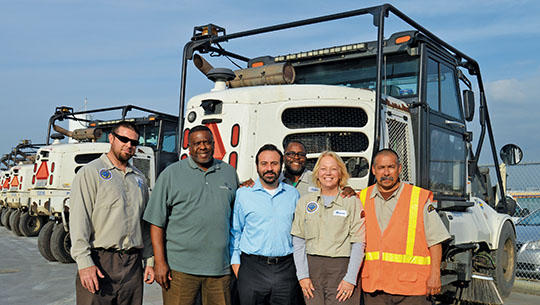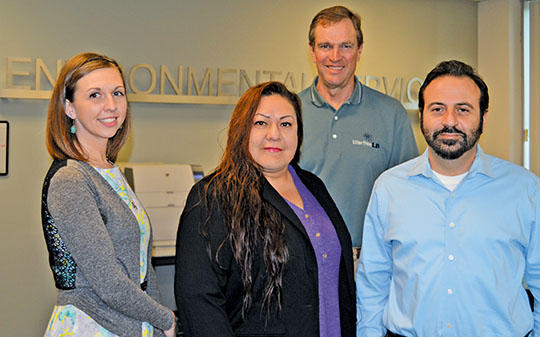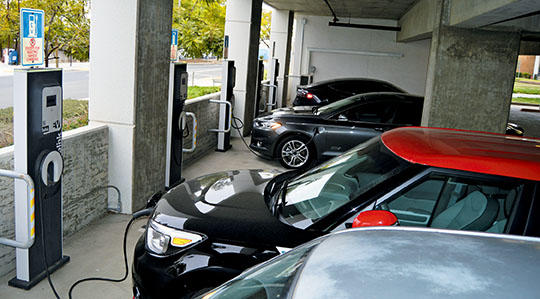Converting compost into car fuel may not be so far off for Long Beach and other major cities in California, where the state has mandated that businesses – mostly large grocery stores and restaurants – start recycling organic waste this year rather than throw it away in the trash.
While such a sustainable concept is still yet to be fully developed, the City of Long Beach is rolling out several new environmental initiatives this year, many of which go beyond federal and state goals to reduce greenhouse gas emissions and to divert waste from impacted landfills.
Environmental initiatives for the city are a key focus of Mayor Robert Garcia, who last November signed on to the “Compact of Mayors,” the largest worldwide coalition of city leaders addressing climate change that was launched at the United Nations Climate Summit in 2014.
Initiatives already underway or planned for Long Beach include: adding more than 1 megawatt of solar panels to city facilities in the next year; planting 6,000 new trees by 2020; requiring Leadership in Energy & Environmental Design (LEED) standards for new private and government development; supporting urban agriculture; and expanding bicycle and pedestrian infrastructure.

Pictured at their Willow Street and Temple Avenue facilities are Long Beach Environmental Services Bureau (ESB) staff members, from left: Jason Wynia; Donald Hansford, superintendent of street sweeping; Diko Melkonian, general superintendent for ESB; Sexton Thompson; Regina Savage, and Daniel Mendez. They are in front of a broom street sweeper, which is being replaced with a new, less expensive and more efficient vacuum street sweeper. (Photograph by the Business Journal’s Larry Duncan)
In addition, the mayor has called for a citywide “clean team” in an effort to deter illegal dumping, while the city’s public works department is already in the process of replacing about 18,000 street lights with more energy efficient light emitting diode (LED) street lights.
Over the next three years, Long Beach plans to take a more comprehensive look at addressing climate change through a collaboration between the city’s office of sustainability, planning department and a team of consultants, said Larry Rich, the city’s sustainability coordinator.
The initiative requires that the city complete a citywide “greenhouse gas inventory” to estimate how much greenhouse gas the city as a whole emits from all sources, including building, transportation, port business, airport activities and water treatment.
The city will then set reduction targets and begin developing climate change “action, mitigation and adaptation” plans, he said.
“Looking at climate action, mitigation and adaptation is something that we’ve never fully taken on before,” Rich said. “It starts with finding a team of consultants to partner with us and get us going. There likely will be firms that have experience doing this in other cities so we can hit the ground running.”
Organics Recycling
A major initiative going into effect this spring involves a new state mandate that businesses start recycling organic waste, which includes spoiled food items and tree trimmings.
The goal is to divert 50 percent of the state’s organic waste, which can be recycled into mulch or fertilizer for tree planting or landscaping, from landfills by 2020, after which the state will conduct a final review of local jurisdictions.
Under Assembly Bill (AB) 1826, businesses generating at least eight cubic yards of organic waste per week are required by April 1 to arrange for the materials to be picked up and recycled separately from trash or regular recyclables.
At first, mostly large grocery stores and major restaurants will be affected by the legislation, but eventually smaller operators will be required to comply, said Diko Melkonian, general superintendent for the Long Beach Environmental Services Bureau (ESB).
By 2017, businesses that generate at least four cubic yards of organic waste per week will be required to arrange for organic waste recycling services while, by 2019, businesses that generate at least four cubic yards of commercial solid waste per week will be required to recycle organic waste.
“We haven’t been able to quantify it yet, but we anticipate that it’s going to divert quite a bit of waste out of the waste stream,” said Melkonian, who added that the state has yet to impose the mandate for apartments or residences.
While the city is required to monitor commercial accounts and make sure they are in compliance through private trash haulers, the City of Long Beach has already had an organics recycling or composting program in place for years and currently surpasses waste diversion requirements, he said.
In fact, nearly 75 percent of waste generated by the city is already diverted from landfills, Melkonian said. According to the latest data collected in 2014, only about 3.9 pounds out of the total 15.2 pounds of waste produced per person in Long Beach is sent to local landfills, already exceeding the 50 percent waste diversion goal the state set for the city, he said.
“Long Beach far outdoes what the state-mandated goal for us is,” Melkonian said. “We’re doing very well, and we’re pretty proud. It’s not just a reflection on city staff and implementing, but it’s also a reflection on the residents and the businesses that take waste reduction, waste management and the environment seriously.”
Future Of Biogas
As businesses start recycling organic waste, opportunities may be on the horizon for such compost materials to be used as fuel for vehicles, city officials said.
According to Rich, necessary infrastructure has yet to be fully developed, but the idea is that considerable amounts of organics may eventually be recycled into “biogas,” an alternative fuel derived from solid waste and considered less polluting than fossil fuels.
“Ultimately, the organics that are being required to be diverted from landfill can go into new processes . . . to turn it into biogas that can then be turned around and used as a motor fuel,” he said. “It takes the [organics] out of the landfills, which is what we need to help [reduce] greenhouse gas emissions.”
The Long Beach Gas & Oil Department (LBGO) is already pursuing biogas as an energy source, said Craig Beck, business operations manager for LBGO. He added, however, that, since the price of biogas is still significantly higher than traditional sources, the commodity isn’t yet viable for residential customers.
Still, there is an opportunity for the city to receive federal transportation credits for the use of compressed natural gas (CNG) vehicles that utilize biogas, Beck said. In fact, the city is already working with Long Beach Transit and other commercial operators to negotiate a biogas usage agreement, expected to go before the city council in the next two to three months, he said.
Optimizing Street Sweeping
Another initiative in Long Beach this year is a street sweeping optimization project.
The goal is to reduce parking impacts in certain neighborhoods, to eliminate conflicts with refuse collection and to move as many four-hour, early morning (mostly 4 a.m. to 8 a.m.) street sweeping times to two-hour times later in the day as possible, Melkonian said.

From left are: Leigh Behrens, recycling specialist for the Long Beach Environmental Services Bureau (ESB); Elisa Calderon, ESB recycling specialist; Charlie Trip, ESB interim director; and Diko Melkonian, general superintendent for ESB. (Photograph by the Business Journal’s Larry Duncan)
“We anticipate that it’s going to bring some much needed relief to a particular area of the city,” he said, adding that a plan to optimize street sweeping will be released later this month.
The project will also involve phasing out the city’s current broom street sweepers, most of which are nearing the end of their useful life, and replacing them with more efficient and less expensive vacuum sweepers, Melkonian said.
The city is expected to acquire at least six new vacuum street sweepers that run on liquefied natural gas (LNG) sometime this year, he said.
More efficient street sweepers will help prevent pollution, including metal dust particles from brakes, entering storm drains that lead to the ocean, Melkonian said.
“Street sweeping is one of our best management practices to keep [pollution] out of the waterways, because otherwise it’s going to go down the storm drain,” he said, adding that the city collects about 11,000 tons of debris a year through its street sweeping program.
EV Infrastructure
The city’s sustainable city commission, meanwhile, is charged with developing policy recommendations to the city council by March on ways to expand electric vehicle (EV) infrastructure.
Rich said the state’s building code already requires that new residential and commercial development incorporate EV plug-in charging stations based on a percentage of parking relative to the size of the development. Long Beach, however, is expected to propose a local initiative that would increase the minimum requirements for new development, he said.
“What we’re being invited to do is figure out if we think it’s reasonable to be more stringent than what the state is already requiring,” Rich said.
While it’s unclear what the total cost will be to private developers, as the city’s policy has yet to be proposed, Long Beach plans to streamline permitting processes for commercial and residential developers interested in EV charging station installations, whether voluntary or by mandate, he said.
Southern California Edison (SCE), the city’s electric utility company, meanwhile, announced in January that the company recently received state approval to launch a pilot program to install up to 1,500 EV charging stations in its service territory.
SCE’s $22 million “Charge Ready” program involves installing EV charging stations in locations where cars are parked for extended periods of time, such as at workplaces, campuses, recreational areas and multi-family residential complexes. If successful, the program may eventually be expanded to 30,000 new charging stations at a cost of $355 million, according to SCE.

This electric vehicle (EV) charging station inside the Long Beach Airport’s parking structure is one of nearly 100 EV charging stations, including 51 EV charging stations, located at city facilities and parking lots, throughout Long Beach. Southern California Edison recently announced that it plans to install 1,500 EV charging stations in the region, including 40 in Long Beach, through a new pilot program. (Photograph by the Business Journal’s Larry Duncan)
Rich said Long Beach, which installed 51 EV charging stations at various city facilities and parking lots about three years ago, is one of many cities participating in SCE’s pilot program. He said SCE is expected to provide about 40 new EV charging stations in Long Beach.
SCE plans to make a major investment in the new EV charging stations in Long Beach, but the pilot program will require the city to also make a financial commitment that has yet to be identified, he said.
In addition, SCE is expected to offer rebates of between 25 and 100 percent of the base cost of the charging stations and installations.
Rich said there are about 50 additional private EV charging stations at various locations around the city, such as at auto dealerships that sell EVs.
There are three levels of EV charging stations, with Level 1 stations taking about eight hours for a full charge, Level 2 stations taking about three to four hours for a full charge and Level 3, also known as DC fast chargers, taking about 30 minutes for a full charge, he said.
Rich said projects to ramp up EV charging stations comes as EV sales have skyrocketed as the number of auto dealers offering EV models to customers has increased from a handful to a dozen over the past few years.
“Electric vehicle sales in California are just going up and up year after year and there’s more and more models out there,” he said. “A lot of cities are being proactive about making sure that there’s good charging infrastructure to support the local EV drivers. All the car companies now are on board and most of them have their own EV charging stations that they’re making available.”
Household Hazardous Waste
The city, meanwhile, continues to encourage residents to dispose of household hazardous waste, such as paint, electronics, expired pharmaceuticals, thermometers, used tires, and sharps – including syringes – at a facility located at the EDCO waste transfer station in Signal Hill, as such materials pose environmental and health hazards and aren’t supposed to enter the regular trash stream.
The amount of household hazardous waste collected at the facility, which is used through a collaboration between the City of Signal Hill, the City of Long Beach and the Los Angeles County Sanitation District, since it was developed in 2013 has increased from 381,000 pounds to 617,000 pounds last year, Melkonian said, adding that the facility is open for household hazardous waste drop off from 9 a.m. to 2 p.m. every second Saturday of the month.
